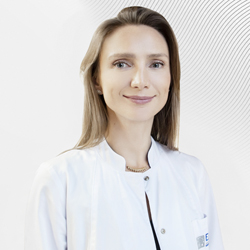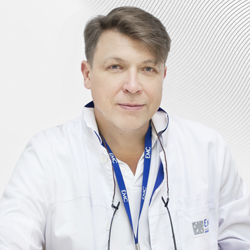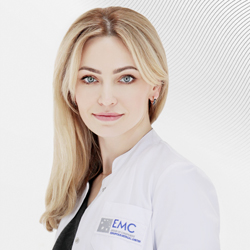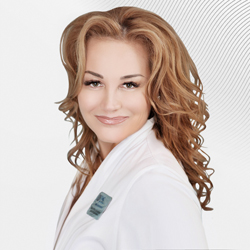Patients often ask this question to their gynaecologist when diagnosed with a uterine fibroid, a tumour formed from muscular fascicles and connective tissue, growing inside or outside the organ. Its causes are not fully understood, but there is no doubt that the growth of this benign tumour is urged along by the oestrogen hormone. Hormonal imbalance, an impaired cell immunity system, as well as a genetic predisposition are also important factors.
Because fibroids occur in the muscular wall of the uterus, at the initial stages of development, it is always intermuscular. Further, if the growth of myomatous node goes in the direction of the serosa of the uterus, the node becomes subperitoneal with a wide base or on a narrow pedicle. In the subperitoneal (subserous) variant, the fibroid site may sometimes be located far from the uterus in its ligaments (intraligamentous). In rare cases, such fibroid may detach from the uterus and be found freely in the abdominal cavity. If the growth of the node is in the direction of the uterine cavity, the node becomes submucosal. The myomatous node can be single and from a few millimetres in size up to 8-10 cm, but rarely larger.
Multiple fibroids of the uterus consist of two or more myomatous nodes, the relative position of which may give the uterus an irregular shape.
The numerous symptoms of uterine fibroids, depending on their location, size, and condition of blood circulation in the node may be split into three groups: menstrual dysfunction, pain, and impaired reproductive function.
In what cases can a fibroid be observed and not operated upon?
There is no universal answer. In addressing this issue, we take into account the wishes of the patient, the presence and severity of the symptoms, age and reproductive plans of the women (desire to have children in the future), decrease in quality of life, size and location of the myomatous nodes, etc. The decision is made together with the patient based on thorough discussion and consideration of possible alternatives. It is possible to resort to conservative treatment. However, they are currently not effective enough. New generation hormonal drugs can halt the growth of fibroids, if the tumour is predominantly composed of muscle fibre and when the muscle layer of the uterus has receptors that permit "catching" these hormones and provide a response. Such therapy helps some, but not others. Treatment with non-steroidal anti-inflammatory drugs somewhat reduces pain and bleeding.
With the beginning of menopause, fibroids usually decrease in size. If a woman approaching menopause turns to specialists at the EMC Gynaecology and Gynaecological Oncology Department with this problem, we usually suggest that she does not rush into surgery. She should be kept under observation and come for a check-up every six months to confirm the absence of rapid growth of the fibroid.
Absolute indications for surgical treatment of uterine fibroids, irrespective of the age of the patient include:
- A fibroid exceeding the size of the uterus during pregnancy at 12-14 weeks;
- Rapid growth of the uterine fibroid (by an amount corresponding to 4-5 weeks' pregnancy over one year);
- Uterine bleeding with a reduction in haemoglobin due to heavy blood loss;
- Acute pain syndrome;
- Secondary changes in the node (necrosis, infection);
- The presence of submucous or subserous nodes of any size on the long pedicles highly prone to torsion;
- Cervical, intraligamentary, nascent node;
- Infertility, miscarriage and preparation for IVF;
- Expressed dysfunction of adjacent organs (frequent urination, prolonged constipation). Due to pressure on the rear wall of the bladder, reflux occurs (reflux of urine into the ureter), and the risk of inflammatory diseases (e.g., aggravation of chronic pyelonephritis) and dilation of the ureters and renal pelvis up to secondary hydronephrosis increases.
The choice and availability of surgery depends on the size and location of myomatous node, patient's age, and her desire to preserve fertility and menstrual function. In the treatment of young women, we are in any case guided by the principle: "Remove the fibroid - keep the womb!" But we must not forget that with a myomectomy, being conservative, organ-sparing, reparative corrective surgery, there is a certain chance of fibroids recurring, which in some cases require a repeat operation.
The EMC Gynaecology and Gynaecological Oncology Clinic performs laparoscopic myomectomies, which has virtually no restrictions on the size of uterine fibroid nodes, hysteroresectoscopic removal of submucous uterine fibroids, and combined laparoscopic-hysteroscopic myomectomies. The issue of hormonal pre-operative preparation of patients is resolved on an individual basis. In the event of multiple myomatous nodes, incisions are made on the wall of the uterus above the surface of each, the nodes are fixed with special instruments, and then removed. The vessels in the bed of the node coagulate (turn into clots), after which complete layer-by-layer reconstruction of a fibre of the uterus wall is carried out by suturing with the latest absorbent suture material. Adequate layer-by-layer restoration of the integrity of the uterine wall is ensured with a laparoscopic myomectomy. Patients who have undergone a myomectomy can start preparing for pregnancy 6-12 months after surgery (on a case by case basis). Most of these interventions can be performed laparoscopically, with the exception of very large nodes that occupy the entire abdominal cavity.
In some cases, the method of choice may be embolization of the vessels feeding the fibroid to stop the growth of the node, causing it to shrink. Targeted treatment of the node with focused high-energy ultrasound is also possible. Both pre- and post-menopausal women are indicated uterine artery embolization and hysterectomies (complete removal) of the uterus, with or without appendages. If the fibroid is not growing or causing discomfort, then treatment is not recommended.

 Write to WhatsApp
Write to WhatsApp













